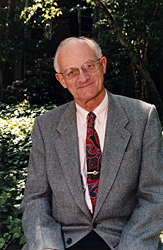A member of the Princeton University faculty for more than 40 years, Billington also serves as director of Princeton's Program on Architecture and Engineering, a position he has held since 1990.
Billington is known for connecting engineering to other disciplines, including the humanities, art, science and politics--an approach whose success he attributes to the environment at Princeton, where “the engineering school is so integral to the University itself.” He has taught some 5,000 Princeton undergraduates since joining the faculty in 1960.
The talk will draw on Billington's latest book by the same title, which was co-authored with his son, historian David Billington Jr. The book tells the story of the engineering behind eight breakthrough innovations that transformed American life from 1876 to 1939 and continue to provide the foundations of our modern society: the telephone, electric power, oil refining, the automobile, the airplane, radio, the long-span steel bridge and building with reinforced concrete. Like the book, the lecture will show how the best engineering exemplifies efficiency, economy, and, where possible, elegance.
Billington makes a clear distinction between invention and innovation: “An inventor takes out a patent on a specific invention. There are hundreds of thousands of inventors but many fewer innovators. An innovator in private industry brings an invention to market so that it has a place in the market economy, while an innovator in public works designs a new type of structure that has widespread impact.” Billington himself has been credited with being an innovator--in the field of engineering education. He said he “thinks of every lecture as a peer-reviewed publication.”
His lectures and teaching exhibitions have earned him national and international recognition. He has taught undergraduate and graduate courses in structures to engineers and architects, and he introduced three permanent introductory courses on engineering at Princeton. One of these, Structures and the Urban Environment, has been given regularly since 1974 and has frequently had the highest enrollment of any course offered by the School of Engineering and Applied Science, including large numbers of liberal arts students.
The recipient of numerous awards, Billington received the National Science Foundation Director's Distinguished Teaching Scholar Award in 2003. He was elected to the National Academy of Engineering in 1986 and more recently was elected a fellow of the American Academy of Arts and Sciences, an honorary member of the American Society of Civil Engineers and an honorary member of the American Concrete Institute.Sponsored by the Department of Civil and Environmental Engineering, the lecture series was initiated in honor of Arnold D. Kerr, professor emeritus of civil engineering, upon his retirement in 2004. He is an internationally recognized expert in engineering mechanics, with a particular focus on railway engineering.
“We are delighted to have Dr. Billington visit the Delaware campus and share his perspective on engineering with us,” Michael Chajes, department chair, said. “This is the second year in a row that we were able to attract an extremely gifted and well-known speaker to the Kerr lecture series. This is a talk that will be of interest to a very broad audience.”
For more information, contact Marikka Beach at [marikka@ce.udel.edu] or (302) 831-2442.
Article by Diane Kukich




